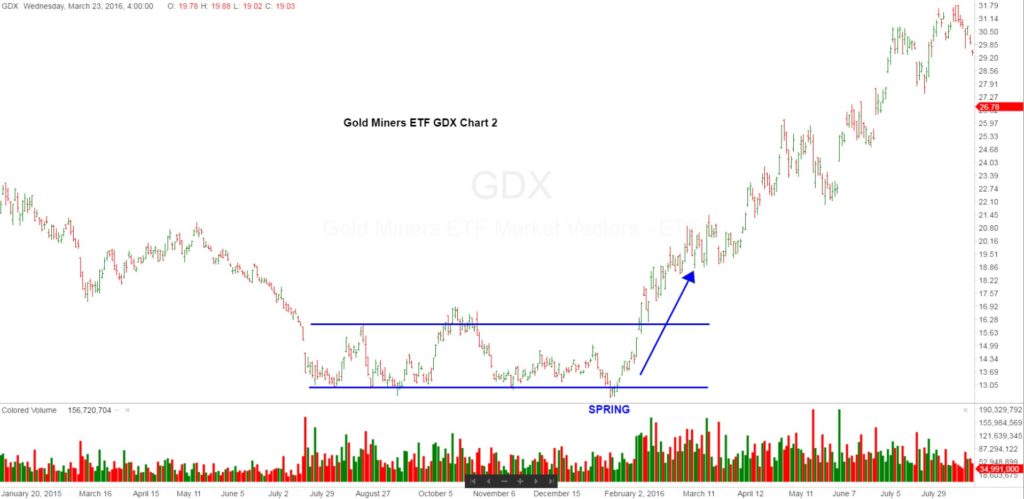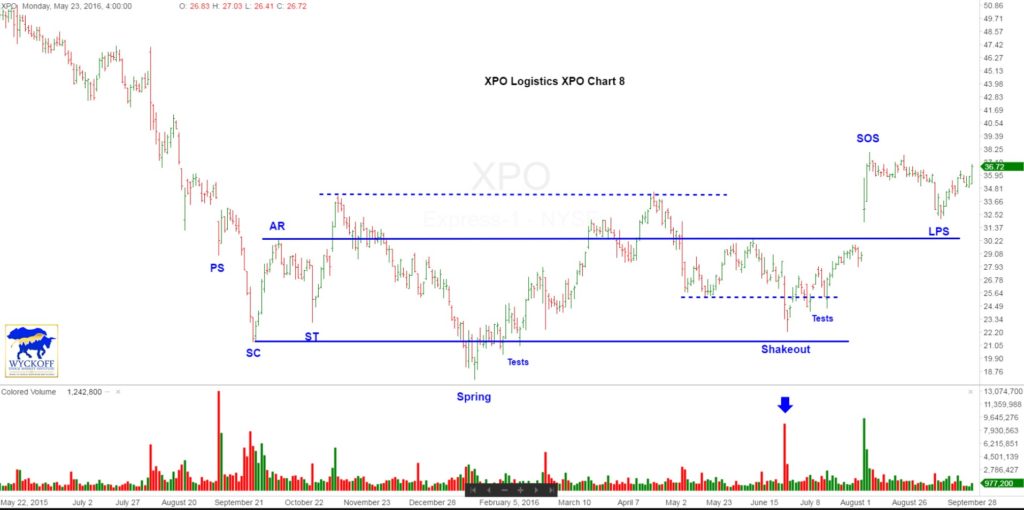The concept of the spring was added to the Wyckoff Stock Market Course by Mr. Robert Evans. Over the years, it has become the primary buying opportunity that is of most interest to many Wyckoff traders. Its popularity can be traced to the fact that the stock market or an individual issue is likely to make an immediate response to the up side that may be the start of a much bigger move that unfolds over time. By buying in a spring position, the stock market trader has the opportunity to take advantage of the entire advance.
Another reason for the popularity of springs has to do with the fact that they represent danger points. It might seem strange to think of a danger point as being a good trading opportunity, but there is a logic to it. When the price is in a spring position, supply has an opportunity to come pouring in an crush the price. This is what makes it a danger point for the bulls. However, if the price has entered the spring position in a constructive manner, the Wyckoff trader knows that the odds of supply rushing in to take control of the action are low. Therefore, it is possible to protect maximum amount of the funds involved and still have an opportunity to realize a worthwhile profit. In effect, the point of greatest danger becomes the point of minimum risk.
Defined in broadest terms, a potential spring position is the penetration of a support level. The words potential spring are used because not all support levels are created equal and not all penetrations are created equal. A support level is defined by the low point of any reaction. Some reactions are more important than others. Therefore, spring that develop relative to those are more interesting to stock market bulls. Not all penetrations of support levels unfold in the same manner. Some are more constructive than others. The character of the price and volume action as the price moves toward into the penetration of a support level determines the quality of the potential spring. High quality springs that develop relative to important support levels are the ones that are likely to produce the best results.
The most important support levels are those that define the bottom of trading ranges. A trading range is where the potential for the next move by the price is built. If the price builds a potential and then moves into a spring position and supply does not pour into the market to crush the price, the bulls can conclude that the potential is for the up side. They can take their positions and let the demand that is attracted as the price moves higher provide a profit. When the price has left the trading range to the up side and the advance is underway, the low points of reactions in the up trend also define support levels. If the price returns to one of these support levels on a later reaction and penetrates it, the result is also seen as being a potential spring. Long positions can be considered on the springs that develop as the advance progresses. However, in these cases, additional factors such as the position of the price in the trend and the remaining up side potential have to be considered and they may argue against buying the spring position. Wyckoff traders should beware of springs that develop during down trends. These frequently fail or result in unimpressive responses.
There are higher quality springs and lower quality springs. The higher quality springs are the ones that are most likely to be successful and produce the best bullish response. The quality of a spring is determined by the depth of penetration below the support level being sprung, the width of the price spreads as the price moves toward and into the potential spring position and the level of volume as the price moves toward and into potential spring position.
There is no particular amount be which the price can penetrate the support level and still be considered a high quality spring. Lower priced issues need to make smaller penetrations than higher priced issues. Mr. Evans never indicated a certain percentage by which the price could penetrate the support level and still be considered high quality. Therefore, each Wyckoff trader needs to make a personal choice as to how deep a penetration can be tolerated. A penetration of one to three percent is seen as being a reasonable criteria to set. Perhaps as much as a five percent penetration could be considered. The problem with selecting a percentage greater than those mentioned is that the ability of the price to climb back above the support level as it responds to the spring diminishes as the depth of the penetration increases.
Price spread is another important factor in determining the quality of a spring. As the price approaches and penetrates the support level, the price spread needs to narrow if the spring is to be seen as being of high quality. Situations where the price spread narrows each day as the price approaches and penetrates the support level are the best. However, an occasional wider spread as the price declines into the potential spring position is acceptable as long as it is not a dramatically wider spread. Those cases where the price approaches and enters a spring position on widening spread and increasing volume should be avoided. These indicate growing weakness and are not likely to result in the desired spring action.
The level of volume is the third factor to consider in judging the quality of a potential spring. As mentioned above, increasing volume as the price declines into the spring normally does not result in a high quality spring. The Wyckoff trader should make a judgment as to what the average volume has been while the price has been in the trading range prior to the decline into the spring position. The volumes as the price approaches and enters the spring position need to be less than average. The best situations are those where the volumes decrease on a day to day basis as the price moves toward and into spring position. There is one instance in which volume can increase and still be seen as resulting in a high quality spring. If the price penetrates the support level on a very narrow spread and that price action is accompanied by an increase in volume, the result can be a high quality spring. This is because the combination of the very narrow spread with the higher volume with the price below the support level is an indication of demand being met to overwhelm the supply that may be present.
Many Wyckoff traders consider the spring position to be the best of the primary buying opportunities. There is no guess work involved in determining whether the price is in a potential spring position. There are a limited number of variables to consider in determining the quality of a potential spring. Defending a position that is established when the price is in spring position is easy. The best factor about buying springs is that the trader can anticipate a prompt positive response.




